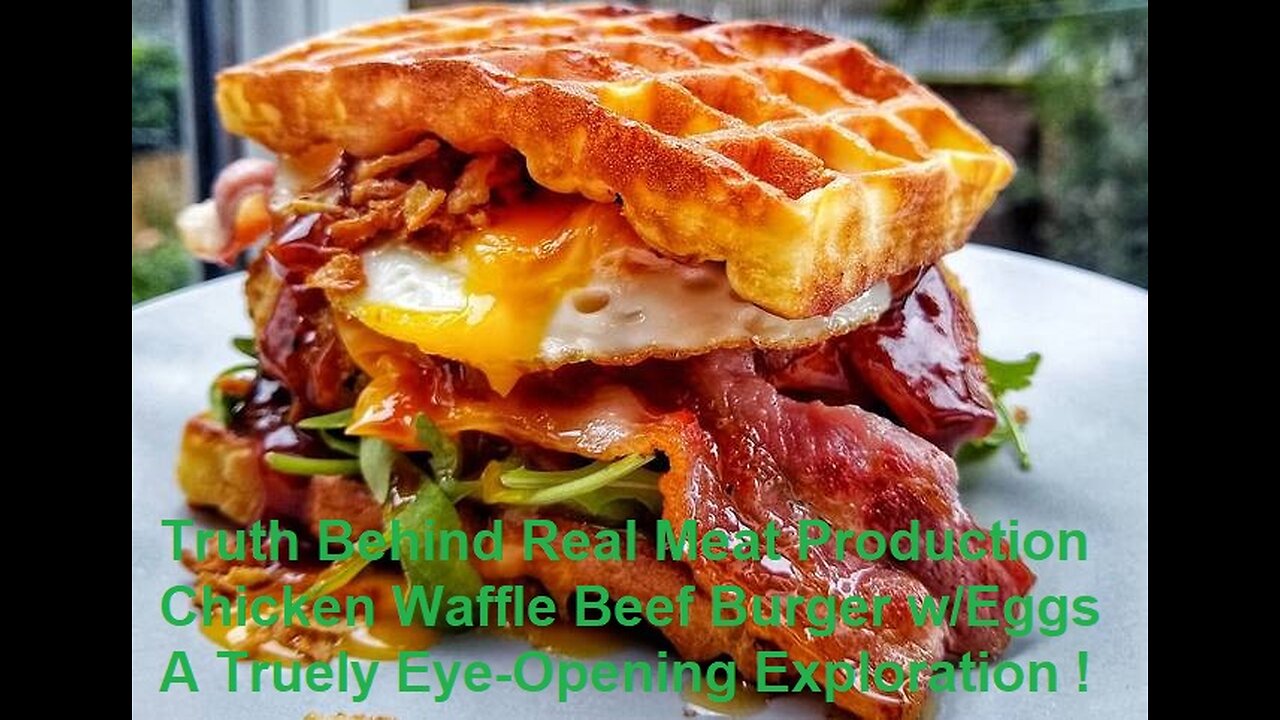Premium Only Content

Truth Behind Meat Production Chicken Waffle Beef Burger An Eye-Opening Exploration
Narrated by Oscar-nominee James Cromwell, this powerful film takes viewers on an eye-opening exploration behind the closed doors of the nation's largest industrial farms, hatcheries, and slaughter plants -- revealing the often-unseen journey that animals make from Farm to Fridge. If this documentary moves you, please take a moment to consider if these animals lives are worth taking for merely taste. Thinking about going vegan? The Truth About the Meat Industry
What is left out of our food labels? Behind the cow industry are disturbing secrets you are not supposed to know. Supermarket beef has become an industrialized, unnatural product laced with lies beyond the labels. What actually happens to that meat before it reaches grocery store shelves? In this blog I’ll unveil the dirty truth behind the cattle slaughter process everyone needs to hear.
“In the U.S., more than 29 million cows suffer and die in the meat and dairy industries every year.” (PETA) Over 50 years ago, before factory farming was born, cow meat was fresh and free of hormones, antibiotics, preservatives, flavor enhancers, mad cow disease, E. coli, age-delayers and additives. Now, artificial manipulation begins before the cows are even born. They are given hormones to make conception timing more efficient for the factories, not the animals. Calves are dehorned, castrated, branded and tagged. They are given multiple vaccinations and antibiotics (often mixed in their feed) to fend off disease. Pumped with growth steroids and fed with “food” used to bulk them up and bring in more money per pound. Cows’ digestive systems were meant to graze grass but the high-volume industry feeds them a grain (and by-products) diet to keep meat cases stocked no matter the season. The antibiotic-laden grain leads to liver abscesses, acidosis in their rumens, illnesses and death. By-products mixed with their feed can range from stale junk food, gum with wrappers, heat-treated garbage, chicken feathers, urea and worst of all--more cows (the reason behind mad cow disease: feeding meat to an herbivore)! Thankfully, in 2004, the FDA restricted cows from being fed mammalian blood products as it was directly linked with mad cow disease. The calves have it bad, but the older cows face no better conditions. The moms are traumatically separated from their calves and given more drugs to make their milk continue to flow. These days, cows are slaughter-ready at just one or two years old. This quick turnaround benefits only the commercial beef industry. It decreases the meat’s nutritional content and increases the chance of bacteria, while traumatizing the animals throughout the process. Additionally, the rates of pollution and chemicals for consumers rises. None of these hormones, steroids, antibiotics and additives ever make it on the food label because the FDA thinks they’re okay.
Everything about the slaughter process, from start to finish, is completely driven by the factory’s wants with no regard to the animals. If cows even survive the feedlots, they are shipped to the slaughterhouse via unimaginably horrific conditions. They are driven hundreds of miles, crammed into trucks often without food, water or rest, and are subject to extreme weather conditions...all while they defecate next to each other. In the heat, some cows collapse; in the cold, some freeze to the sides of the truck and are peeled off with a crowbar. No joke.
The cattle that survive the journey to the slaughterhouse are often too weak to walk. “Uncooperative animals are beaten, they have prods poked in their faces and up their rectums,” a former USDA inspector revealed. Cattle are forced down a chute and shot in the head with a captive-bolt gun, which is supposed to make it so they can’t feel pain. However, the assembly line’s goal is speed; more cows killed equals more money. The workers never stop, whether an animal is alive or not. Sometimes the animals’ legs are cut off while they are 100% conscious. Other times, cows’ throats are cut and they continue suffering for as much as seven minutes afterward. The poor animals are murdered one part at a time. What kind of sick show is this?
It doesn’t even stop there. Once the cows are butchered, they are cleaned and injected with a cocktail of water, salt, preservatives and a chemical solution to “enhance” flavor, mask any foul ones, prolong the meat’s “freshness” or make it more tender. Much of this meat is then placed in airtight Modified Atmosphere Packaging (MAP) and inserted with gases to delay the aging process and make it appear fresher/redder for longer during transit and on store shelves. Many meat packagers purposefully leave off the “packaged on” date, because if you saw that you wouldn’t buy it. All these processes are meant to provide more profits for the companies while worsening the health of the consumers. And the majority of the public is completely unaware this entire process is even happening! If they knew...would they still support this industry? This is why I am sharing! If we don’t inform ourselves, no one else will. The government and food agencies are not interested in our health. Are you disgusted yet? Good! You should be. And now you are armed with knowledge and motive for change. There are better options for you, your family, the animals and our planet. Options that don’t hurt cows, your health and our earth!
Don’t forget about the astronomically devastating environmental impacts and pollution caused by cattle farming. This infographic captures it well--check it out and be informed. Here’s just a couple of the statistics it lists: if ONE person changes to a vegan diet instead of eating meat, they can reduce carbon dioxide emissions by 1.5 TONS A YEAR! Raising animals for food uses almost HALF of our water supply in the U.S. and takes up 30% of the world’s land mass! Whoa!
One of the best choices you can make for our world is to adopt a vegan, animal-loving diet and philosophy. In my next blog, I will share tips on how to go vegan...or at least take baby steps toward lessening your impact on animals and the environment. Not ready to quit meat cold turkey (no pun intended)? Start by eating meat one less day a week (i.e. Meatless Monday). Reference that infographic again to see all the difference you’ll make--per meatless meal! When you see how easy that is, try bumping your meat-free days to two, three, four or more. And if on any days you do have meat, make sure it is organic and grass fed! This is currently the only standardized way (short of knowing your farmer) to ensure your meat didn’t go through everything this article talks about.
Stay tuned for more! And if you found this blog eye-opening, please share it with a friend. And have that friend share it, too. The more people who know the truth behind the meat industry, the more lives are changed by the power of knowledge, choice and informed action. We can change the cycle by starving it. Don’t give this industry any more money; they are poisoning animals, us, and our world! Thank you!
Transport to the Slaughterhouse
Cattle who survive feedlots, dairy sheds, and veal farms face a hellish trip to the slaughterhouse. They are crammed onto trucks where they typically go without food, water, or rest for the duration of the journey, which can sometimes be days. Many cows collapse in hot weather; in the cold, cows sometimes freeze to the sides of the truck until workers pry them off with crowbars.
By the time the exhausted cows reach the slaughterhouse, many are too sick or injured to walk. These cows, known to the meat and dairy industries as “downers,” often have ropes or chains tied around their legs so that they can be dragged off the trucks.
Of those animals who arrive at the slaughterhouse healthy enough to walk, many are frightened and don’t want to leave the truck, so they are shocked with electric prods or dragged off with chains. “Uncooperative animals are beaten, they have prods poked in their faces and up their rectums,” says a former USDA inspector.
In the summertime, when it’s 90, 95 degrees, they’re transporting cattle from 1,200 to 1,500 miles away on a trailer, 40 to 45 head crammed in there …. [In the winter], can you imagine if you were in the back of a trailer that’s open and the windchill factor is minus 50 degrees, and that trailer is going 50 to 60 miles an hour? The animals are urinating and defecating right in the trailers, and after a while, it’s going to freeze, and their hooves are right in it. If they go down—well, you can imagine lying in there for 10 hours on a trip.
—Former U.S. Department of Agriculture (USDA) veterinary inspector Dr. Lester Friedlander
Slaughter: ‘They Die Piece by Piece’
After they are unloaded, cows are forced through a chute and shot in the head with a captive-bolt gun meant to stun them. But because the lines move so quickly and many workers are poorly trained, the technique often fails to render the animals insensible to pain. Ramon Moreno, a longtime slaughterhouse worker, told The Washington Post that he frequently has to cut the legs off completely conscious cows. “They blink. They make noises,” he says. “The head moves, the eyes are wide and looking around. … They die piece by piece.”
Another worker, Martin Fuentes, told the Post that many animals are still alive and conscious for as long as seven minutes after their throats have been cut. “The line is never stopped simply because an animal is alive.” Because the industry makes more money the more animals it kills, workers who stop to alert officials to abuses at their slaughterhouse risk losing their jobs. The meat industry thrives on a workforce made up largely of impoverished and exploited workers, many of them immigrants who can never complain about poor working conditions or cruelty to animals for fear of being deported.
The best way to help put an end to this cruelty is to stop eating meat and other animal products. Order PETA’s free vegetarian/vegan starter kit today for great tips and free recipes to help you make the transition to an animal-friendly diet.
What You Need to Know About The Beef Industry You can’t see it. And you can’t always recognize it by reading the label. But the beef in your supermarket has gone industrial.
Before factory farming took hold in the 1960s, cattle were raised on family farms or ranches around the country. The process was elemental. Young calves were born in the spring and spent their first months suckling milk and grazing on grass. When they were weaned, they were turned out onto pastures. Some cattle were given a moderate amount of grain to enhance marbling (the fat interlaced in the muscle). The calves grew to maturity at a natural pace, reaching market weight at two to three years of age. After the animals were slaughtered, the carcasses were kept cool for a couple weeks to enhance flavor and tenderness, a traditional process called dry aging. The meat was then shipped in large cuts to meat markets. The local butcher divided it into individual cuts upon request and wrapped it in white paper and string.
This meat was free of antibiotics, added hormones, feed additives, flavor enhancers, age-delaying gases and salt-water solutions. Mad cow disease and the deadliest strain of E. coli — 0157:H7 — did not exist. People dined on rare steaks and steak tartare (raw ground beef) with little fear.
What’s in Your Beef?
Today’s beef industry process brings cattle to slaughter weight in just one or two years. But it reduces the nutritional value of the meat, stresses the animals, increases the risk of bacterial contamination, pollutes the environment and exposes consumers to a long list of unwanted chemicals.
The U.S. beef supply contains traces of hormones, antibiotics and other chemicals that were never produced by any cow. That hamburger looks fresh, but it may be two weeks old and injected with gases to keep it cherry red. Take a closer look at that “guaranteed tender and juicy” filet of beef. The juiciness may have been “enhanced” with a concoction of water, salt, preservatives and other additives.
More ominous, the beef also may be infected with food-borne bacteria, including E. coli 0157:H7. Some experts believe this toxic E. coli evolved in cattle that were fed high-grain diets. Every year, hundreds of thousands of pounds of beef products are recalled. One of the largest recalls to date took place in October 2007 when Topps Meat company recalled 21.7 million pounds of hamburger because of potential E. coli contamination. The massive recall actually put the company out of business.
And now there’s mad cow disease, a mysterious disease that is not destroyed by cooking and has been fatal. You could ingest “prions” (abnormal proteins) by eating even a well-done rib roast. These prions infiltrate your brain, perforate it with holes, and cause death in a few years’ time.
The artificial manipulation of beef begins prior to conception. Many cows are treated with synthetic hormones, such as “melengestrol acetate,” that regulate the timing of conception, allowing all the calves to be born within days of each other — a “more efficient” process. In many ranches, herd bulls have been replaced by artificial insemination, which is a fast (read: more efficient) way to improve herd genetics. The goal is consistent size, tenderness and marbling. But beef industry insiders predict that many ranchers will be using cloned cattle in five or 10 years. The mass-produced calves will be carbon copies of each other. The Food and Drug Administration (FDA) granted preliminary approval of cloning in December 2006, declaring that the meat is indistinguishable from normal meat, and is as safe for human consumption. In similar circumstances, no labeling has been required.
Goodbye Grass, Hello Feedlot
After the calves are born, they spend the first seven to nine months grazing on grass, the same way calves have been raised for generations. But when they reach 500 to 700 pounds, they are herded into trucks and shipped to auction barns where they’re sold to new owners and trucked to distant feedlots. The journey can take up to a week. Upon arrival at the feedlot, the stressed, thirsty and hungry calves are herded down chutes and subjected to a number of procedures, which can include dehorning, castration, branding and tagging. Then they are dewormed and vaccinated against various diseases. A common practice is to mix antibiotics with the feed, whether the now-stressed animals show signs of illness or not. Tetracycline, an antibiotic important for humans, is one of the most commonly used medications.
Lastly, the calves are implanted with pellets that contain growth-promoting steroid hormones that lose their effectiveness in a matter of months. Many animals are given new implants of higher potency to replace them. The aggressive use of hormone implants can add 110 pounds of lean meat or more to a calf. Every dollar invested in implants returns five to 10 dollars in added gain for each animal in the six to 12 months they spend in the feedlot.
Are Hormone Implants Safe?
Given the fact that nine out of 10 U.S. calves are treated with hormonal growth promoters, you can assume that most of the beef in your supermarket contains hormone residues. The FDA has approved five hormone implant growth promoters for cattle. Three of them — estradiol, progesterone and testosterone — are naturally occurring hormones that are identical to those found in humans. Zeranol and trenbolone acetate are synthetic hormones that mimic natural ones. In addition, melengestrol acetate is approved as a feed additive. Some implants contain a mix of these various substances.
Many consumers and advocacy groups are calling for a ban on these growth-promoting implants. They point to research showing that even trace amounts can promote tumor growth. At the Ohio State University, cancer researchers mixed human breast cancer cells with trace amounts of Zeranol, one of the five hormones used in U.S. cattle. Zeranol caused a significant spurt in tumor growth, even at levels 30 times lower than levels the FDA maintains are safe.
The European Commission Health and Consumer Protection Directorate-General has identified more than a dozen additional studies that raise concern about the safety of the implants, including the possibility they might cause birth defects and changes in sexual development in children. Weighing all the evidence, the European Union (EU) has banned the use of implants. They also refuse to import U.S. beef from animals treated with hormones. Although EU scientists concede there is no clear proof that the implants are harmful to humans, they assert there also is no proof that they are safe. What’s more, they say, Europeans have expressed a clear preference for hormone-free beef, even if no health risks are found. The World Trade Organization, at the urging of the U.S. government, now levies trade sanctions against the EU for closing their doors to U.S. beef.
Meanwhile, the FDA stands by its claim that beef from implanted cattle contains such small amounts of these drugs that they pose no threat to human health. In fact, the FDA is so confident in its ruling that it does not require hormone use to be listed on labels.
Grain and Antibiotics Go Hand in Hand
Hormones are just one way to speed the growth of young calves. Another strategy is to feed them an ultra high-grain diet, the standard fare in most feedlots. One reason calves are switched from grass to grain is that grain is a more concentrated form of energy. Calves fattened on grain reach maturity months ahead of grass-fattened calves. The less time cattle spend in feedlots, the greater the profit they return. Corn is the grain of choice because it’s especially high in energy.
Grain-feeding has another advantage: It keeps the assembly line moving steadily throughout the year. Grass becomes sparse during periods of drought and cold weather, which slows the growth of the calves. Grain is available year-round, allowing calves to gain as much weight in January as they do in June. It also keeps the meat cases stocked all year, a luxury we now take for granted.
But unnatural high-grain diets have a major drawback: They make cattle sick. To prevent or reduce the symptoms caused by grain-feeding, they are given a steady dose of antibiotics in their feed — adding yet another drug to the mix.
Why does grain-feeding cause health problems? Cattle, sheep and other grazing animals have a specialized stomach chamber called a “rumen.” The rumen is designed to convert fibrous plants such as grasses into a nutritious, easily digested meal. Replace the grass with grain and the rumen becomes too acidic. After several months, the condition can progress to “acute acidosis.” Cattle with acute acidosis develop growths and abscesses on their livers, stop eating, sicken and even die.
Retired animal science professor Jim Hayes, who holds a doctorate in reproductive physiology and animal science, and manages grass-based Sap Bush Hollow Farm in Warnerville, N.Y., puts it bluntly: “A high grain diet blows out their livers.” To keep the calves alive and gaining weight, they must be given a steady diet of antibiotics.
Even with these countermeasures, many calves develop “subacute acidosis,” a more aggressive form of acid indigestion. A calf with subacute acidosis will hang its head, drool, kick at its belly and eat dirt. Alarmingly, this is regarded as “natural” in the feedlot. According to an article in the trade magazine, Feedlot: “Every animal in the feedlot will experience subacute acidosis at least once during the feeding period. … This is an important natural function in adapting to high-grain finishing rations.” When calves are finished on high-grain diets, a certain amount of suffering is simply taken for granted.
Antibiotics as Growth Promoters
The calves are given antibiotics for yet another reason, one that has nothing to do with preventing or treating disease. Quite by accident, ranchers discovered that small doses of antibiotics called “subtherapeutic doses” allow animals to make more efficient use of their feed. (Antibiotics can boost metabolic rate, nutrient absorption and protein synthesis.) According to a 2001 report by the Union of Concerned Scientists, an estimated 70 percent of all the antibiotics used in the United States are now being given to healthy animals to improve their growth and performance.
Many scientific and medical groups — including the American Medical Association — are calling for a reduction in the use of antibiotics in animals. The practice is creating and spreading antibiotic-resistant strains of bacteria. When people or animals are treated with antibiotics, a small percentage of the bacteria survive because of genetic differences. Once all the normal bacteria are destroyed, the resistant bacteria are free to grow without competition. If you were to become infected with these bacteria, the drug used to treat the cattle would be ineffective. Alarmingly, half of the drugs being used to treat animals are identical or nearly identical to those used to treat humans.
A number of European countries have greatly reduced animal use of antibiotics. In Denmark, farmers voluntarily suspended use of antibiotic growth promoters by more than 60 percent without any significant economic impact.
Virtually all the beef in your supermarket comes from animals that were treated with growth-promoting antibiotics. You can’t tell by reading the label, however, because the FDA doesn’t require antibiotic use to be listed. It’s agribusiness as usual.
Chewing Gum, Spent Hens and Garbage
There seems to be no end to cost-cutting measures in the modern feedlot. To further lower the cost of feed, which accounts for 60 percent or more of the total cost of raising cattle, many cattle are fed “byproduct feedstuffs.” This can range from nutritious ingredients such as beet pulp and carrot tops, to junk: stale bread or candy and heat-treated garbage. As one feedlot operator told me, “Byproduct feedstuff is anything that is cheap, keeps the cattle growing and can be found close to the feedlot.”
In New York state, chewing gum has been used as a cheap feed supplement. The novel practice was recommended in a 1996 study in the Journal of Animal Science. The study concluded that stale chewing gum — still in its aluminum wrappers! — can “safely replace at least 30 percent of [cattle] growing or finishing diets without impairing feedlot performance or carcass quality.” In other parts of the country, cattle are being finished on stale pizza dough and candy bars, even heat-treated garbage. Feedlot operators drive to the manufacturing plants or municipal landfills and load up their trucks with this yummy fare, or they buy the used goods from middlemen called “jobbers” who offer a more varied buffet.
According to a May 21, 2007, article in The Wall Street Journal, reliance on junk food has shot up in recent years because the cost of feed corn has doubled due to the increased use of corn for ethanol production. According to the article, one farmer now feeds his cattle a ration that is 17 percent stale candy and 3 percent stale “party mix.” Another feeds a 100 percent byproduct diet, including French fries, tater tots and potato peels.
Some byproduct feedstuffs are high in protein and are considered a welcome addition to a high-grain diet. This list includes chicken feathers, salvaged pet food, ground-up laying hens (known as “spent hen meal”) and urea, a non-protein source of nitrogen synthesized from ammonia and carbon dioxide that is widely used as fertilizer. Urea can sicken cattle if not mixed carefully with feed.
The USDA does not require producers to tell you what the animals were fed.
An Industry Gone Mad
Beyond the obvious “yuck” factor, there is a compelling reason to restrict the use of byproduct feedstuffs in cattle production: It can spread mad cow disease, the most frightening disease in the history of the beef industry. Until 1997, many of the cattle in the United States and Europe were fed blood, meat and bone meal from other cattle. Scraps of meat and bone left over from the slaughtering process were rendered (heat-treated), ground into meal and then fed back to the cattle. In essence, cattle were being fed to cattle, turning herbivores into carnivores — and cannibals.
No one realized that abnormal proteins called prions could survive the rendering process and transmit a deadly brain-wasting disease called bovine spongiform encephalopathy (BSE), commonly known as mad cow disease. Now research strongly suggests that people who ingest meat from BSE-infected cattle can be inflicted with a related and deadly brain disease, variant Creutzfeldt-Jakob disease (vCJD). As of July 2007, there have been three cases in the United States in people who are believed to have contracted the disease in other countries, and 201 cases worldwide, most of them (166) in the United Kingdom. Only 13 of the people who have contracted the disease since 1990 are still alive.
An Attempt to Clean Up the Feed Supply
Mad cow disease helped pull in the reins on an industry that was getting out of control. In 1997, the FDA ruled that the rendered products of cattle, sheep, deer and goats could no longer be fed to other ruminants. They also took steps to remove from the food supply the types of meat tissue most likely to carry BSE, including the small intestine, spinal cord, brain and other nervous tissue.
In 2004, the agency also banned the practice of feeding mammalian blood products to cattle, because new research showed that blood also can transmit BSE. Blood was a common ingredient in the milk “replacer” fed to dairy calves. Feeding poultry litter was banned as well. Poultry litter is a polite term for the blanket of manure, shavings, spilled feed, dead birds and feathers that accumulates on the floor of large poultry operations. It can be a hidden source of BSE-infected beef, because the FDA still allows meat and bone meal from cattle to be fed to chickens.
The beef industry now uses a mechanical process called Advanced Meat Recovery (AMR) to strip every scrap of meat from the bones. AMR increases the risk that spinal cord and other nervous tissue that can harbor BSE will enter the food supply. The Food Safety and Inspection Service has tightened the regulations about which parts of the animal can be stripped, but the process is not risk free.
Mad Cows and You
Most of the beef we now consume comes from cattle that were born after the United States Department of Agriculture (USDA) removed the most hazardous ingredients from cattle feed and banned sensitive beef tissue from the human food chain. Therefore, your risk of vCJD is lower than it was a couple years ago and much lower than it was 10 years ago.
For many people, however, these safeguards are not enough. Some maintain that the USDA is testing too few cattle to get an accurate measure. In other words, if they tested more animals, they’d find more disease. Another cause for concern is that BSE has been found in ordinary meat from sheep, not just the brain, intestines and spinal cord. Some fear that prions might be found in the steaks and roasts of cattle, as well.
Centralized beef processing magnifies whatever danger exists. If tissue from just one BSE-infected cow is ground into hamburger and mixed with meat from other cattle, tons of meat would be contaminated. This is what has happened many times already with E. coli 0157:H7 contamination. Unlike other food-borne diseases, cooking does not destroy the prions that cause mad cow disease.
Japanese health authorities are equally skeptical about the safety of U.S. beef. To protect the health of Japanese citizens, they test every animal for BSE, including the beef imported from the United States. Many people urge the United States to adopt the same rigorous standards.
So far, the USDA has refused to extend its testing program, claiming there is no scientific justification for such an extraordinary measure. It also asserts that wide-scale testing might give the false impression that the U.S. beef supply is unsafe. To maintain the aura of safety, the USDA prevented individual companies from testing their own cattle. (Read more about this in Mad Cow Disease: Should the USDA do More? December 2007/January 2008.) When Creekstone Farms, a Kansas cattle company, successfully sued the USDA in federal court to be allowed to begin testing for BSE in June 2007, the government agency filed an appeal, blocking the testing. In an unprecedented move, the USDA has even banned the marketing of BSE test kits, saying that the test procedures have not received their official approval. Since 2003, dozens of countries have issued total or partial bans of U.S. beef because of their concerns about mad cow disease. Some have since been lifted.
Less Nutritious Too
Mad cow disease, hormone implants and the excessive use of antibiotics may dominate the headlines, but there’s another problem caused by taking cattle off grass and fattening them on grain and byproducts: The meat loses nutritional value. Grass is a richer source of healthy fats and antioxidants than grain, and as a direct result, meat from grazing animals has more of these nutrients than meat from grain-fed cattle. In a study published in the journal Meat Science in 2005, a team of Argentinean researchers determined that grass-fed meat is higher in vitamin C, vitamin E and beta carotene.
Omega-3 fatty acids are another vital nutrient that’s diminished by a feedlot diet. Calves start losing their stores of omega-3s as soon as they start eating grain. By the time they’re ready for market, very little of this heart-healthy fat remains. Conjugated linoleic acid (CLA) is a fat that appears to be a potent cancer fighter. CLA is higher in grazing animals than in feedlot animals. The longer the animals graze, according to a study published by the Journal of Animal Science, the higher the CLA content of their meat.
While we know some of the nutritional effects of feeding grain to cattle, no one has studied how byproduct feedstuffs affect the meat. But it is reasonable to assume that a steak from a cow that got 30 percent of its calories from chewing gum will be lower in a number of vitamins and healthy fat. Garbage in; garbage out.
Make My Beef Truly Fresh and Truly Natural
The beef industry and government regulators go to great lengths to assure the public of the safety of the U.S. beef supply. We are told that the meat is inexpensive, safe and abundant. The National Cattlemen’s Beef Association, the public policy center for the beef industry, denies that grain-fed beef is less nutritious than grass-fed meat, and dismisses organic grass-fed beef as a mere “niche market.”
Meanwhile, dozens of countries around the world and millions of American consumers are increasingly skeptical of the U.S. beef industry and of the ability of the government to regulate it in the best interests of the consumer. In record numbers, people are buying beef from small-scale producers who raise cattle on pasture and choose not to supplement with grain, byproduct feed, hormones or antibiotics. These savvy consumers are placing their vote of confidence in beef made the old-fashioned way — cows grazing green grass and growing at their natural pace. Learning more about beef and its alternatives is the key to being able to choose healthy, natural beef.
So You Want Better Beef?
Finding an alternative to industrial beef takes effort. The beef industry is highly consolidated, with the largest 25 feedlot companies now supplying 40 percent of all U.S. beef. The packing industry is even more concentrated. The top four beef packers (IBP/Tyson, Excel/Cargill, Swift/ConAgra and U.S. Premium/National Beef) harvest more than 80 percent of the meat. By contrast, in the 1960s the top four packers slaughtered less than 30 percent of all cattle. The trend is likely to continue, partly due to the fact that food giants, such as Wal-Mart and Safeway, cut costs by reducing their number of suppliers. Except for a small section of the meat case devoted to “natural meats,” all the remaining beef you see in the stores comes from animals that were fed high-grain diets and treated with hormones, antibiotics and other pharmaceuticals.
But you can find beef from cattle that were not fed filth, pumped up with hormones or treated with unnecessary antibiotics. And you can make sure it’s good and fresh. Better choices are beginning to pop up in natural and specialty grocery stores, on the Internet and in a growing number of traditional supermarkets. Here are a few pointers on how to find them:
Opt for organic. The use of growth-promoting hormones and antibiotics is not allowed in certified organic beef production. Nor is feed made from animal byproducts, including meat, blood and bone meal from chickens, pigs and ruminants.
Go for the grass. Choose beef from cattle that were 100 percent “grass-fed” or “grass-finished.” These animals are raised on their natural diet of grass from birth to market, and are not routinely given antibiotics and hormones. Look for a comprehensive grass-fed label from the American Grassfed Association in the coming months.
Look at labels. Check for phrases like “Naturally Raised,” “No Hormones Added,” “Raised Without Antibiotics” and “Never Fed Animal Byproducts.” But don’t be afraid to do a little detective work; these kinds of labels rely primarily on the integrity of the producers, rather than independent certifying agencies.
Comb your community. Don’t be afraid to ask your local producers how they raise their beef, and beware those who don’t want to answer you! You can find producers near you at farmers markets and on the Web. Try Eat Wild or Local Harvest.
Poke the package. Look for thin, flexible plastic wrap that clings to the meat. Modified atmospheric packaging, or MAP, requires meat to be wrapped in thick, gas-impervious plastic with enough head room to trap the gases that keep the meat looking fresh for an unnaturally long time.
Deduce the date. Meat must have a “Sell by” or “Use by” date that states how long the meat is likely to remain safe to eat. But producers are not required to tell consumers when the meat was packed. Processors who use MAP avoid listing the packing date, as it would spoil the illusion of freshness. Look for meat that tells you exactly when the meat was packaged for sale.
Buy beef and nothing but. It’s easy to avoid injected beef. The large print usually boasts “Extra Tender and Moist” or “Marinated for Flavor.” But the fine print of the label reveals injections of up to 30 percent of a mysterious water-and-chemical concoction.
Processed is the New “FRESH”
Ten years ago, virtually all the beef on the market met the United States Department of Agriculture’s (USDA) definition of “natural,” which means it has been minimally processed and contains no added ingredients, colors or preservatives. Now, beef is “flavor and moisture enhanced,” meaning it has been injected with a water-and-chemical solution — a marinade concocted by a chemist, not a cook — to make it look fresher longer, mask off-flavors or make it more tender and juicy.
In addition, a growing percentage of beef is treated with Modified Atmosphere Packaging, or MAP. Raw meat is placed in airtight packages and injected with gases to delay or disguise the normal aging process. The meat industry hopes that MAP will save up to a billion dollars a year by keeping the meat in the display cases longer.
The irony is that pastured cattle have enough natural antioxidants in their diet to keep their meat truly fresh longer than feedlot beef. What the processing plants try to do with a mix of chemicals, Mother Nature does on her own. To read about injected and gas-packed meat in greater detail.
Meat Consumption: Myths and Facts More than half of Americans who make New Year’s resolutions resolve to “eat healthier." If you’re one, you might be confused about the role meat should play in your health.
It’s no wonder you’re confused. One group of scientists says that reducing red and processed meat is a top priority for your health and the planet’s. Another says these foods pose no problems for health. Some of your friends may say it depends, and that grass-fed beef and “nitrite-free” processed meats are fine. At the same time, plant-based meat alternatives are surging in popularity, but with uncertain health effects.
As a cardiologist and professor of nutrition, I’d like to clear up some of the confusion with five myths and five facts about meat.
First, the myths.
Myth: Red meat is good for health
Long-term observational studies of heart disease, cancers or death and controlled trials of risk factors like blood cholesterol, glucose and inflammation suggest that modest intake of unprocessed red meat is relatively neutral for health. But, no major studies suggest that eating it provides benefits.
So, while an occasional serving of steak, lamb or pork may not worsen your health, it also won’t improve it. And, too much heme iron, which gives red meat its color, may explain why red meat increases risk of Type 2 diabetes. Eating red meat often, and eating processed meat even occasionally, is also strongly linked to colorectal cancer.
Myth: You should prioritize lean meats
For decades, dietary guidance has focused on lean meats because of their lower fat, saturated fat and cholesterol contents. But these nutrients don’t have strong associations with heart attacks, cancers or other major health outcomes.
Other factors appear more important. Processed meats, such as bacon, sausage, salami and cold cuts, contain high levels of preservatives. Sodium, for example, raises blood pressure and stroke risk, while the body converts nitrites to cancer-causing nitrosamines. Lean or not, these products aren’t healthy.
Myth: Focus on a ‘plant-based’ diet
“Plant-based” has quickly, but somewhat misleadingly, become a shorthand for “healthy.” First, not all animal-based foods are bad. Poultry and eggs appear relatively neutral. Dairy may have metabolic benefits, especially for reducing body fat and Type 2 diabetes. And, seafood is linked to several health benefits.
Conversely, many of the worst foods are plant-based. Consider white rice, white bread, fries, refined breakfast cereals, cookies and so on. These foods are high in refined starch and sugar, representing 42% of all calories in the U.S., compared to about 5% of U.S. calories from unprocessed red meats, and 3% from processed meats.
Either a “plant-based” or omnivore diet is not healthy by default. It depends on what you choose to eat.
Myth: Grass-fed beef is better for your health
Conventional livestock eat a combination of forage (grass, other greens, legumes) plus hay with added corn, soy, barley or grain. “Grass-fed,” or “pasture-raised,” livestock eat primarily, but not exclusively, forage. “Grass-finished” livestock should, in theory, only eat forage. But no agency regulates industry’s use of these terms. And “free range” describes where an animal lives, not what it eats.
“Grass-fed” may sound better, but no studies have compared health effects of eating grass-fed versus conventional beef. Nutrient analyses show very modest differences between grass-fed and conventionally raised livestock. You might eat grass-fed beef for personal, environmental or philosophical reasons. But don’t expect health benefits.
Myth: Plant-based meat alternatives are healthier
Products like Impossible Burger and Beyond Meat are clearly better for the environment than conventionally raised beef, but their health effects remain uncertain. Most nutrients in plant-based alternatives are, by design, similar to meat. Using genetically engineered yeast, Impossible even adds heme iron. These products also pack a lot of salt. And, like many other ultra-processed foods, they may lead to higher calorie intake and weight gain.
So, what are the facts?
Fact: Processed meats are bad for health
Processed meats contain problematic preservatives. Even those labeled “no nitrates or nitrites added” contain nitrite-rich fermented celery powder. A current petition by the Center for Science in the Public Interest asks the FDA to ban the misleading labeling.
Besides the sodium, nitrites and heme, processed meats can contain other carcinogens, produced by charring, smoking or high-temperature frying or grilling. These compounds may not only harm the person who eats these products; they can also cross the placenta and harm a fetus.
Fact: A meatless diet is not, by itself, a healthy diet
Most diet-related diseases are caused by too few health-promoting foods like fruits, nuts, seeds, beans, vegetables, whole grains, plant oils, seafood and yogurt. Additional health problems come from too much soda and ultra-processed foods high in salt, refined starch or added sugar. Compared to these major factors, avoiding or occasionally eating unprocessed red meat, by itself, has modest health implications.
Fact: Beef production is devastating the environment
In terms of land use, water use, water pollution and greenhouse gases, unprocessed red meat production causes about five times the environmental impact of fish, dairy or poultry. This impact is about 20 times higher than that of eggs, nuts or legumes, and 45 to 75 times higher than the impact of fruits, vegetables or whole grains. A 2013 UN report concluded that livestock production creates about 15% of all global greenhouse gas emissions, with nearly half coming from beef alone.
Fact: Plant-based meats are better for the environment
Production of plant-based meat alternatives, compared to conventional beef, uses half the energy, one-tenth of the land and water, and produces 90% less greenhouse gas. But, no studies have yet compared plant-based meat alternatives to more natural, less processed options, such as mushrooms or tofu.
Fact: Many questions remain
Which preservatives or other toxins in processed meat cause the most harm? Can we eliminate them? In unprocessed red meats, what exactly increases risk of Type 2 diabetes? What innovations, like feeding cows special strains of seaweed or using regenerative grazing, can reduce the large environmental impacts of meat, even grass-fed beef? What are the health implications of grass-fed beef and plant-based meat alternatives?
Like much in science, the truth about meat is nuanced. Current evidence suggests that people shouldn’t eat unprocessed red meat more than once or twice a week. Grass-fed beef may be modestly better for the environment than traditional production, but environmental harms are still large. Data don’t support major health differences between grass fed and conventional beef.
Similarly, plant-based meat alternatives are better for the planet but not necessarily for our health. Fruits, nuts, beans, vegetables, plant oils and whole grains are still the best bet for both human and planetary health.
What is lab-grown meat? How it's made, environmental impact and more Your complete guide to the nutrition, ethics and sustainability of a food revolution in the making. It wasn’t long ago that the idea of the meat on our plates coming from vast stainless steel bioreactors, rather than farmed animals, seemed like science fiction. The notion has gone through numerous rebrands since its early positing as ‘vat meat’, which triggered unappealing visions of high-tech Spam.
‘Lab meat’ came next, as scientists perfected the recipe in small beakers in laboratories. Then came the more appetising-sounding ‘cultured meat’, as investment from high-profile individuals rocketed and producers positioned these products as having been brewed, just like beer. Now, ‘cultured meat’ has evolved to ‘cultivated meat’, which is the preferred term used by CEOs in the industry.
Whatever you choose to call it, with the future of global food security in question, and farmed meat a key culprit in climate breakdown, slaughter-free meat is starting to look increasingly like the future of food.
How is lab-grown meat made?
Rather than being part of a living, breathing, eating and drinking animal, cultivated meat is grown in anything from a test tube to a stainless steel bioreactor. The process is borrowed from research into regenerative medicine, and in fact Prof Mark Post of Maastricht University, who cultured the world’s first burger in 2013, was previously working on repairing human heart tissue.
Cells are acquired from an animal by harmless biopsy, then placed in a warm, sterile vessel with a solution called a growth medium, containing nutrients including salts, proteins and carbohydrates. Every 24 hours or so, the cells will have doubled.
How different is cultivated meat from the real thing?
Cellular farming doesn’t grow cuts of meat, with bone and skin, or fat marbled through it like a succulent ribeye steak. Muscle cells require different conditions and nutrients to fat cells, so they must be made separately. When the pure meat or fat is harvested, it is a formless paste of cells. This is why the first cultivated meat products served up have been chicken nuggets or burgers.
The flavours, however, are of real meat. As they are produced in a sterile environment, there is less risk of contamination from disease and chemicals. This is in contrast to conventional agriculture where, says San-Francisco based Josh Tetrick, CEO of GOOD Meat, “you have a live animal slaughtered on the floor. If you look at the Salmonella, E. coli, faecal contamination that’s part of animal agriculture, it looks much better from a cultivated meat perspective than it does from a conventional meat perspective.”
Is lab-grown meat as nutritious as regular meat?
A spokesperson for UPSIDE Foods, a San Francisco-based leader in the cultivated meat arena, says that the nutrient profile will be similar, but it will also be possible to enhance or even personalise it.
“We are exploring ways to improve the nutrient profiles of our products. Whether that’s less saturated fat and cholesterol, or more vitamins or healthy fats,” they said. “For instance, imagine if we could produce a steak with the fatty acid profile of salmon? Or what if consumers could customise the nutrient profile in their products to meet their dietary needs?”
As there are so few cultivated meat products on the market requiring food labelling, we’ll have to wait to get a better understanding of the nutritional value.
When can people buy it?
People in Singapore already can. Tetrick’s company, GOOD Meat, has been producing and selling its chicken in Singapore since December 2020 at special events, both in an upscale hotel restaurant and the legendary Mr Loo’s hawker stall.
Breaded chicken and shredded chicken have both gone down well. Tetrick says the company has applied to the US Food and Drug Administration (FDA) for approval in the US, but no timescale has been given.
Other producers say that Western countries are still ironing out the details of how regulatory approval will work, but say they’ll be ready to scale up as soon as approval is given in the coming years.
Is it better for the environment?
The truth is, we can’t know until mass production is happening. Modelling the potential impacts of a fast-moving biotech industry that’s still in development is subject to many ifs and buts. One 2019 study from the University of Oxford warned that the energy used to make cultivated meat could release more greenhouse gases than traditional farming.
Pelle Sinke, researcher at Netherlands-based sustainability consultancy CE Delft, who was not involved in the research, says the part of the study that assumed use of electricity generated by a large proportion of fossil fuels highlighted the importance of renewable energy for cultivated meat production.
“In some scenarios, cultivated meat had a higher global warming effect, and in some scenarios a lower effect, depending on consumption levels, expected energy use for cultivated meat and the beef cattle system it was compared to,” he says.
Sinke adds that the study doesn’t, however, take into account the lower land use of cultivated meat. “[There’s] the possibility to use that land for plant-based protein production, nature and extra renewable energy production, which in turn influences the CO2 emissions of cultivated meat,” he says.
His own team has also been investigating the environmental impact and he says that while cultivated meat is no silver bullet to solve all the world’s problems, “it certainly has a lot of potential because it directly offers a more sustainable alternative to conventional meats. It is a more efficient way of converting crops into meat, and therefore much less land is needed to produce these crops.
"But it does use more energy. For a lower carbon footprint than conventional meats, it is crucial that renewable energy sources are used in its production, including in the supply chain – importantly for the production of nutrients and other ingredients needed for the culture medium.”
All of the companies contacted for this article – Mosa Meat, GOOD Meat and UPSIDE Foods – understand that building sustainable energy into production is essential.
What challenges need to be overcome?
A vegan growth medium
Until recently, in order to kick-start cell division, about 20 per cent of the growth medium had to be foetal bovine serum, drawn from the blood of a cow foetus. Not only is the serum prohibitively expensive, but it’s also distinctly not vegetarian.
But all the major players now claim to have developed an alternative. In early 2022, Post and his team published an academic paper about their foetal bovine serum alternative. The process uses genetically modifying yeast to produce the necessary proteins. This technology, called precision fermentation, is similar to how medical insulin is made (we have a lot more than beer and bread to thank yeast for!). Post says that there is a whole new burgeoning industry for producing vast vats of productive microorganisms.
Tetrick admits, however, that there are still challenges with scaling up the alternatives, and that his chicken in Singapore is produced with foetal bovine serum. “[It’s] not because we want to, but because it was included when we initially submitted our application, because we hadn’t solved it when we submitted,” he says. “We’re awaiting regulatory approval to produce without it.”
Mass production
Tetrick says that scale is the next great hurdle to clear. You need to be churning out “a minimum of 15 million pounds [6.8 million kilos] per year at a facility, which is sort of a rule of thumb for national distribution across the US or Western Europe.”
This will necessitate bioreactors that hold at least 200,000 litres, which has never been done in cell culture. “People eat it every week in Singapore… right now the largest size that we’re [producing in] is 1,200 litres, which is very small, relative to what is required. In my mind, this is the single biggest limiting step of the entire industry.”
Only when produced at scale can the price come down and compete with cheap, intensively farmed meat. Meanwhile, GOOD Meat’s Singapore operation is currently running at a loss, selling hawker stall dishes for four Singapore dollars (around £2.50). When launched in the West, all the products will start off at expensive restaurants – adding cachet to their launches – and can only trickle down to affordable supermarket prices with economies of scale.
Texture
Yes, much of the world’s meat consumption consists of burgers, nuggets and sausages. But what if we want a juicy, cultivated steak? How do we turn meaty mush into a choice cut? It’s a fast-moving picture, but GOOD Meat’s current solution for their chicken products is to pair it with more structured vegetable proteins.
Its offering in Singapore is 73 per cent chicken. “[And then the rest] is binders and fillers,” says Tetrick. “We’re trying to optimise it for the sensory and consumer experience: taste, texture, flavour profile, cost.”
Cellular agriculture trailblazers argue that it’s cheap burgers and chicken that are using up the majority of the one-third of the planet that’s currently dedicated to growing farm-animal feed, so these products are both the most urgent and easiest to get to market. To achieve the texture of steak, says Tetrick, scaffold technology will be necessary, as a way of building structure inside the vessel. This scaffold will most likely be made using vegan collagen.
Ethically, can everyone eat it?
Now that the foetal bovine serum is out of the way, vegetarians could, ethically speaking, eat this meat – if they have an appetite for it.
The religious element is a little trickier. For meat to be permissible under Islamic and Jewish laws, there are strict rules on how animals are slaughtered and how the meat is prepared. Cultivated meat is set to trigger lively debates among religious leaders around the world (interpretations of scriptures vary geographically), and has already started doing so in some zones.
Would cultivating meat from kosher or halal meat cells solve the problem? In Indonesia, which has the world’s largest Muslim population, the influential Muslim organisation Nahdlatul Ulama has reportedly given a statement putting cultivated meat in “the category of carcass which is legally unclean and forbidden to be consumed.”
In contrast, the Muslim-majority country Qatar is heavily investing in the technology, and building a production plant with GOOD Meat.
Meanwhile, in the London Beth Din (Court of the Chief Rabbi), there’s excitement at the prospect of a meat that could be a neutral food, under kosher law. Foods in milk or meat categories must be kept separate, so to have a neutral meat could provide a convenient loophole. And it could eventually provide cheaper kosher meat, which traditionally tends to be expensive.
As Rabbi Conway says: “This is an extraordinary breakthrough and potentially a very exciting development for the kosher consumer. If the meat was available on a commercial scale, we would need full details of the manufacturing process and the ingredients used to rule whether it was kosher, but potentially this could make life easier and cheaper for kosher consumers.”
What would happen to farmers and their animals if cultivated meat takes off?
“We envision that small-scale conventional farming will still be used for premium meat cuts and dairy products for years to come,” says Post. “This protein transition will happen over decades, and innovations rarely completely replace existing practices. Cellular agriculture has the potential to create a more balanced and symbiotic relationship between small-scale farmers, consumers and the planet.”
Post’s team is already partnering with a farmer in the Netherlands, who keeps a free-roaming, high-quality herd of Limousins, raised not for slaughter, but for regular biopsies for Mosa Meat’s burgers. “The same way that crop farming currently provides feed for animals, we also require feed for our cells, using the same type of nutrients a cow needs,” says Post. “We will work with farmers to grow the crops needed to feed our beef cells.”
UPSIDE Foods takes a similar view, while Tetrick says GOOD Meat is developing a beef line, culturing meat cells from a company called Toriyama, which is a high-end wagyu beef producer in Japan. “That’s another interesting thing about cultivating meat – you can use these high-end meat sources and the cost to do it isn’t any more,” Tetrick says.
It’s not just meat that can be cultivated
Dairy, without the cow
From milk to ice-cream to cream cheese, Perfect Day’s milk protein is already available in over 5,000 stores across the US. But instead of being made by cattle, it’s produced by a fungus genetically programmed to create cow whey protein, using the same precision fermentation technology responsible for medical insulin. And the best bit: it’s lactose free.
Egg whites, without the chicken
Precision fermentation is used by Every Company to make egg white, as well as a soluble version of the protein that even the fussiest palate would be hard-pressed to taste or see, making it an ideal additive for protein-boosting drinks and other products.
Bluefin tuna, but no fishing
As the name suggests, Finless Foods is creating animal-free fish. The company cultures bluefin tuna cells in what it calls a microbrewery-style production facility. I was lucky enough to attend an early prototype testing in 2017, and I can confirm that the fish croquettes tasted subtly of a sea in which the cells had never swum.
No-hunt exotic beasts
Start-up Primeval Foods sees the next logical step in culturing meat cells as a chance to taste exotic, off-limits animals such as lion and zebra. After launching in 2022, Primeval Foods is already promising imminent tastings in London and New York, and has so far released pack shots of tiger steak and zebra sushi rolls.
-
 13:19
13:19
What If Everything You Were Taught Was A Lie?
14 days agoWhere The Outrage Poison Food Jillian Michaels Receives Standing Ovation After Speech
3.49K7 -
 UPCOMING
UPCOMING
Game On!
11 hours agoCollege Football Playoff Round 1 BEST BETS! | Indiana vs Notre Dame Preview
111 -
 14:15
14:15
This Bahamian Gyal
17 hours agoDC server REFUSED to serve Donald TRUMP, then THIS happened . . .
1354 -
 13:47
13:47
MichaelBisping
12 hours agoBISPING Reacts: "Tyson Fury will RETIRE and F&$K UP USYK?!" | Usyk vs Fury 2
922 -
 14:15
14:15
Tactical Advisor
12 hours agoNew Ruger Glock Clone | Magpul RXM (FIRST LOOK)
47.7K22 -
 7:55
7:55
The Nima Yamini Show
19 hours agoWho Is Controlling Facebook and Instagram? The Truth About George Soros and Meta’s Oversight Board
42.1K73 -
 3:45
3:45
BIG NEM
11 hours agoDiscover Your Ikigai: Finding Your Ultimate Purpose
23.6K1 -
 13:19
13:19
Dermatologist Dr. Dustin Portela
1 day ago $6.03 earnedDo You Have Sebaceous Filaments or Blackheads?
16.4K3 -
 2:21:35
2:21:35
Price of Reason
15 hours agoThe Establishment WORRIES about Elon Musk AGAIN! Superman Trailer Discussion! Sonic 3 Review!
48K3 -
 1:14:54
1:14:54
Steve-O's Wild Ride! Podcast
18 hours ago $22.77 earnedZac Brown Reveals The Secrets To HIs Success - Wild Ride #247
89.1K15